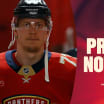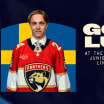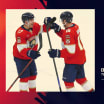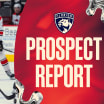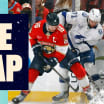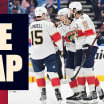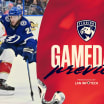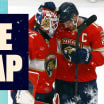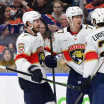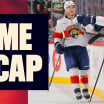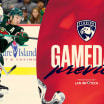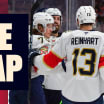Throughout our 25th Anniversary season, we look back at some greatest highlights of Florida Panthers history remembered by the reporters who experienced it firsthand. First up: Brian Biggane, who covered the team for over a decade for the Palm Beach Post.
The media availability following the Panthers' practice between Games 1 and 2 of the 1996 Stanley Cup Final in Denver was winding down when a reporter approached Scott Mellanby with a request he had heard roughly 999 times over the previous eight months.
Tales from the Press Box: Looking Back at the Rat Craze
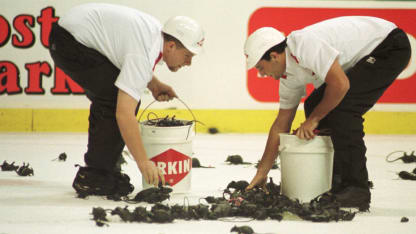
By
Brian Biggane @bbiggane / FloridaPanthers.com
"Could you tell the story about the rat one more time?" Mellanby looked at me, standing a few feet away, and a mischievous smile spread over his face.
"Should I?" he asked me.
I smiled back, knowing one of the most media-friendly players I met in my 42-year sports writing career would once more lay out the tale that to this day stands as the most iconic in the 25-year history of the franchise.
It was during the first intermission of the home opener against Calgary on Oct. 8, 1995, and coach Doug MacLean had just finished offering some thoughts to his players seated on benches around the tiny locker room inside Miami Arena. As the players rose to head back to the ice a startled rat ran across the room. Stick in hand, Mellanby instinctively swatted it into the nearby door jam. The rat twitched a few times and expired.
Mellanby would score two of his career-high 32 goals in a 4-3 win that night, and as the unsuspecting media headed into the jubilant locker room it was goaltender John Vanbiesbrouck who would let on what had happened a couple hours before.
"'Mell' had a rat trick tonight," said a grinning Beezer. "Two goals and a rat." With that he pointed to a spot by the door where someone (I always suspected Paul Laus) had written "R.I.P. Rat."
That game began a six-game homestand, and by the time it ended fans had captured the moment, tossing plastic rats on the ice after every Panthers goal. Stores around the arena and even the arena concessions themselves began stocking up as fans wanted to get in on the phenomenon. Every game was a sellout in the 15,000-seat arena, which was small enough that anyone with a good arm could hurl one to the ice surface.
Soon enough the Panthers were arming their front-office employees with shovels, sending them out after every home goal to collect the dozens and dozens of plastic toys that were unleashed after every home goal and pouring them into large white buckets, no doubt to be dispatched to the same souvenir stands that had sold them for $5 apiece only hours before.
Commissioner Gary Bettman threatened to impose a delay-of-game penalty, but there was no stopping the craze once it got rolling, and hey, the rats had quickly become the symbol of this gritty team that had captured the imagination of South Florida. Beyond that, it was Bettman himself who had helped sell NHL owners on the idea hockey could work in an area that had regarded ice first and foremost as a main ingredient in the making of a mojito.
Whatever thoughts league officials had of a crackdown disappeared completely when Marti Huizenga, wife of Panthers owner Wayne Huizenga, was spotted with her own stash of plastic rats, reaching up from her seat along the glass to flip them over the top. Now even celebrities were onto it.
Everywhere on the road the Panthers would go it was the first line of inquiry: When did this start? Were the players having fun with it? Were they worried about the league stepping in? Was this even legal?
The players, of course, were unequivocal: This was fantastic. In only their third season they were the talk of South Florida. Fans who had been drawn to watch games by a gimmick were quickly learning that nothing in sports is quite like in-person hockey, with its speed, physical play, dramatic goals and great personalities.
On that last count this team had so much to offer. Captain Brian Skrudland worked hard on the ice and never stopped smiling off it. His assistant, Mellanby, was in his prime as a goal-scorer, while grinders Tom Fitzgerald and Bill Lindsay were among the league's best defensive forwards. Rookie defenseman Ed Jovanovski hit opposing forwards like a Mack truck and boyish-looking center Rob Niedermayer had the girls gushing over his good looks.
Then there was the Beezer.
Claimed from the New York Rangers in the 1993 expansion draft, Vanbiesbrouck, still in his prime at age 32, used his cat-like quickness and superb glove to shore up a defense that, while gritty, had its share of shortcomings after the No. 1 pair of Robert Svehla and Terry Carkner.
This roster, of course, was nothing like what the Vegas Knights would boast after their expansion draft of 2017. The league allowed teams to protect only a handful of players to allow Vegas to become competitive immediately; the Panthers, like expansionist partner Ottawa, were stocked with third- and fourth-line players teams mostly considered easily expendable.
And that became their bond.
Buoyed by the rat craze and their own work ethic, the Panthers rolled through the first two-thirds of their schedule, reaching a high point of 35-17-7 after a 4-1 win at New Jersey on Feb. 21. Then the wins stopped coming, and losing streaks of five and four games in March left them needing a win over the Rangers in their season finale to secure home ice in the first round of the playoffs.
First-period goals by Ray Sheppard, Niedermayer and Mellanby staked the Panthers to a 3-0 lead and the rats flew all night as the Panthers celebrated a 5-1 win and their first-ever playoff berth.
Florida won the first three games of the series, with the 4-2 win over Boston, prompting Bruins' fans to throw their own mementoes - in this case garbage - on the ice in the final minutes. But Boston rebounded for a 6-2 win in Game 4, and when the Bruins tied Game 5 at 3 on a goal with 7:31 to play Panther fans knew they were one bad break away from a Game 6 back in Boston.
That left it up to Lindsay to score what many still call the biggest goal in franchise history, streaking around future Hall of Fame defenseman Ray Bourque to flip a shot between the pads of goalie Bill Ranford for the winner with 4:57 remaining.
One of the biggest Panthers, Jovanovski, and one of the smallest, Stu Barnes, had huge roles in the six-game conference semifinal elimination of Philadelphia. Jovanovski's vicious hit on Eric Lindros turned the tide in a 4-3 win in Game 4 that tied the series at 2, and Barnes' overtime goal at The Spectrum in Game 5 put the Panthers in position to end the Flyers' postseason with a 4-1 rout in Game 6.
Then came the conference final in Pittsburgh, and a scene no one was at Miami Arena that night will ever forget. Down 3-2 in the series and needing a Game 6 win to stay alive, the Panthers got the winner from Niedermayer with 6:02 to play. As the crowd roared and the rats flew seemingly from everywhere, Penguins goaltender Tom Barrasso retreated into his net and crouched in a turtle pose.
It could be argued that Barrasso's psyche was still damaged when Game 7 arrived in Pittsburgh two nights later; that at least appeared to be the case when Fitzgerald's bouncer from beyond center ice early in the third period somehow beat him for the deciding goal in a 3-1 win. The celebration of capturing the Prince of Wales Trophy went deep into the night and into the next day; some players insist to this day they needed more than another two days to prepare for their Finals matchup with Colorado, a series they would lose 4-0.
South Florida celebrated the team's success at yet another packed Miami Arena a few nights later, and the accomplishments of that underdog team remains one of the high points of our sports history.
And it all started with one dead rat.

